ALL..ABOARD!: West Hopkinton Station
Introduction
Text-to-speech Audio
Images
Image of the West Hopkinton station.
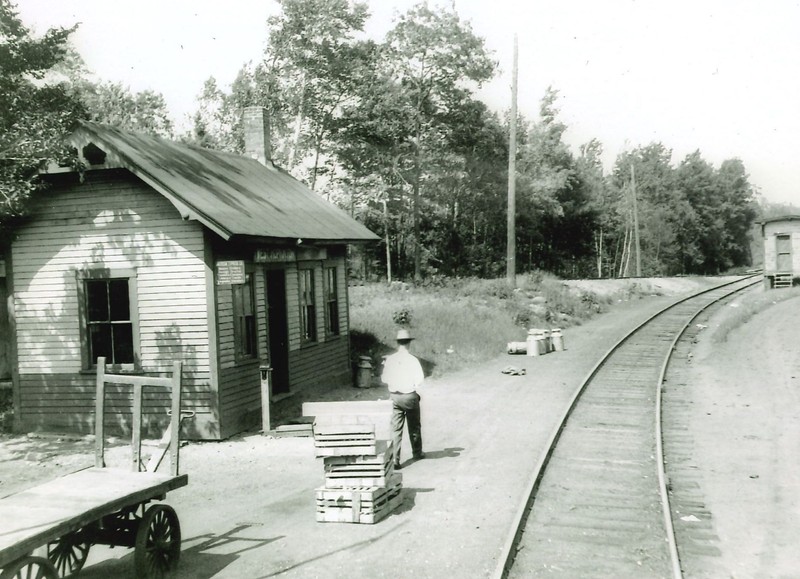
Image of the West Hopkinton station relative to the Rowell Covered Bridge.
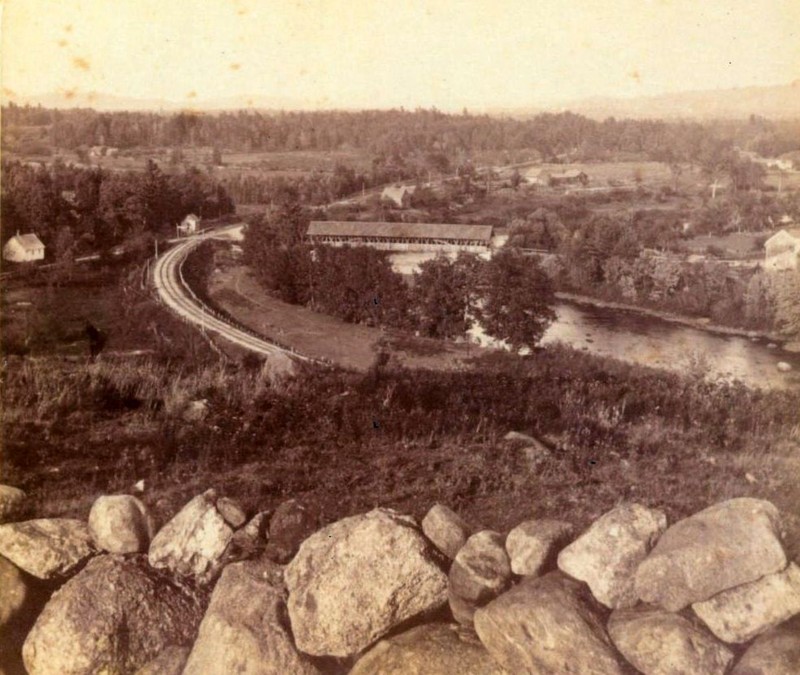
Photograph of Henry Chase Davis, one of the owners of Davis Paper Company in West Hopkinton.
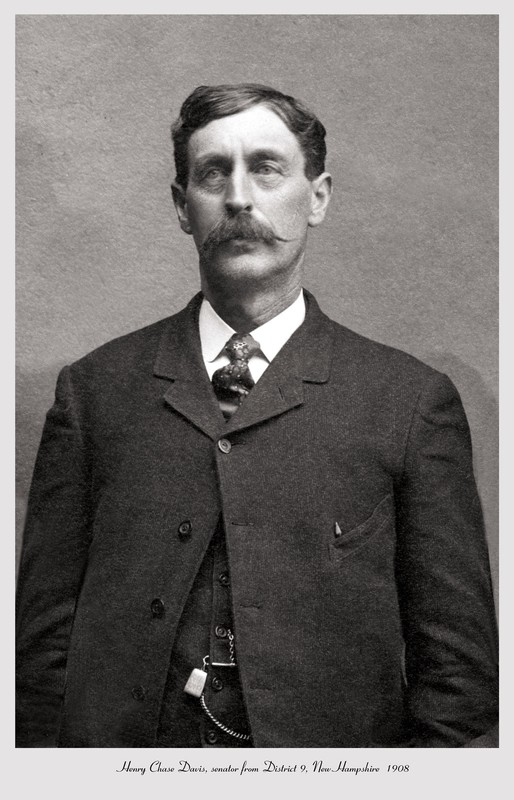
An early 20th-century postcard with a colorized photo of the mills at West Hopkinton. Visible in the foreground are the railroad tracks that delivered fuel to the facility.
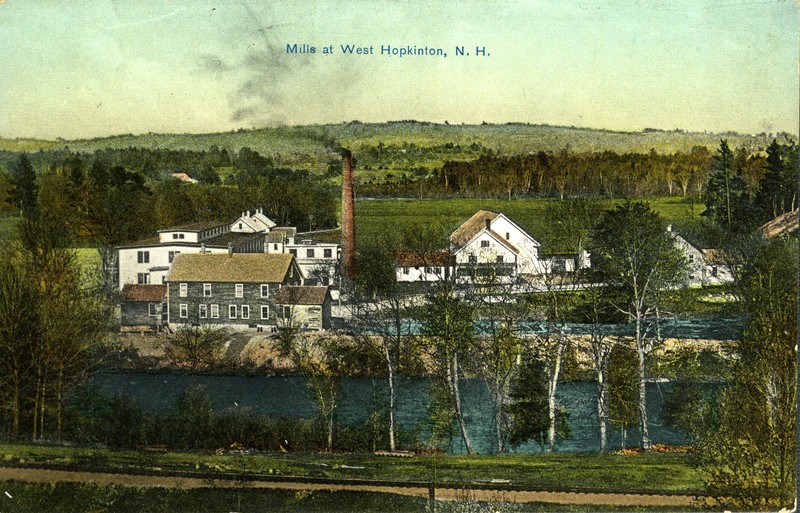
Image of West Hopkinton before construction of the Hopkinton-Everett Dam.
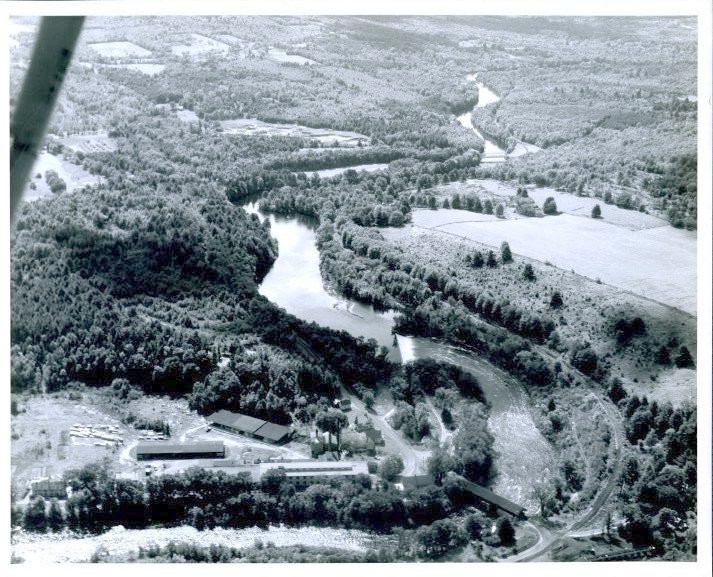
Image of West Hopkinton after construction of the Hopkinton-Everett Dam.
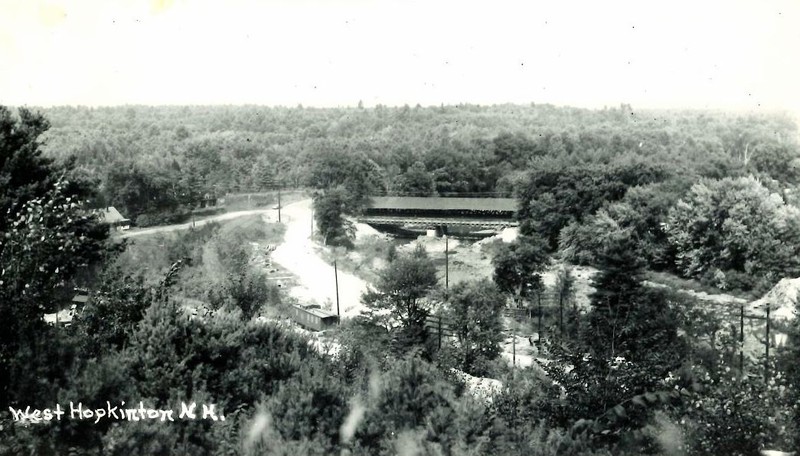
Backstory and Context
Text-to-speech Audio
Davis Paper Company
The area along the Contoocook River at West Hopkinton has been the site for several mills since early in Hopkinton’s settlement. The bend in the river and the drop in elevation adds to the power the river provides to turn the wheels to saw lumber and grind grain. With the introduction of the railroad through this area in 1849, transporting goods beyond the Town’s borders to new and larger markets became feasible.
But the mill that had the biggest impact on the area was the paper board and leather board manufacturer – Davis Paper Company. In 1906 Henry C. Davis and his brother Horace J. Davis, having recently sold their mills in Davisville, bought the Rowell family farm and the water rights from Frank H. Carr, with the intention of building new mills. The mill buildings would contain state-of-the-art manufacturing machinery; a new dam was constructed; tenement housing for workers was built; and electricity and telephone were brought in. In addition to these buildings, the Davis’s built a warehouse on the opposite side of the river, next to the railroad station.
The railroad company, by then owned by Boston & Maine Railroad, added new side tracks to accommodate the shipping of finished goods and the receiving of raw materials. Taking more than two years to complete, it was such an accomplishment that the Davis’s opened the mills to the public for a night of dancing and music. A special train was hired to carry people to and from the festivities. By several accounts, it was a most exciting celebration with between 500 and 600 people in attendance from several towns.
The Davis Paper Company changed the character of West Hopkinton, bringing in a new population of workers with their families, who needed groceries and sundries which they could buy at the Davis General Store. The West Hopkinton Post Office moved into the store too. And the children attended school in the one-room school house across the covered bridge, near the railroad station. West Hopkinton was a busy community in the early 20th-century.
In 1947 the Davis Paper Company was purchased by Hoague and Sprague which produced cardboard.
Hopkinton-Everett Dam
Much of the landscape has changed in West Hopkinton since the building of the Hopkinton-Everett dam project by the Army Corps of Engineers, which began in the late 1950s. Many family farms were lost due to the construction of the dam and related reservoir and spillways. Portions of roads connecting neighborhoods, such as Bassett Mill Road, were removed. Others, such as routes 9 and 202, were rerouted, while sections of railroad track towards Henniker were removed. Additionally, the Stumpfield Cemetery had to be relocated.
The justification for such upheaval was that the Contoocook River, which had caused major flooding many times over the centuries, had again caused significant flooding twice in the 1930s. In 1936 flooding was caused by severe storms and in 1938 by a hurricane. The floods left roads washed out and much of Contoocook Village flooded, with the covered railroad bridge suffering significant, though repairable, damage. The floods also wiped out the railroad bridge to Henniker, ending rail service from West Hopkinton to Henniker. By the time the dam project was started, twenty years later, the only train service to West Hopkinton was freight, bringing in coal, via Contoocook, to power the remaining mill, until it converted to oil. By 1962, the dam construction was completed and the last railroad delivery to West Hopkinton had been made.
In Conclusion...
The history of Hopkinton’s railroad covers a little more than 100 years – from the first passenger train arriving in Contoocook in 1849 to the last freight train delivering coal to the paper mill in West Hopkinton in 1962. It brought tremendous change to our area – to the physical landscape, the markets for our agricultural products, and our ability to get from one place to another. It also brought changes to wealth distribution, land ownership (eminent domain), and transient populations. Some of the changes were positive; others were less so.
Below are several questions to think about and discuss. There are not right or wrong answers to them. They are starting points to spark discussion about current experiences and lessons learned, if any, from history.
- Land needed to be acquired before construction of the railroad began, some of which was done using eminent domain. Do you support the use of eminent domain? What other examples of the use of eminent domain are there (Hopkinton-Everett Dam, construction of Interstate 89)? Are there parallels with the colonists taking of land from the Native Americans?
- The railroad lobby had undue influence in New Hampshire (and other states), contributing to political campaigns and offering free passes to legislators. Should businesses be allowed to lobby? How can people help ensure that more voices – not just those with the biggest budgets – are heard?
- Many of us are familiar with the fate of the Concord, NH, railroad depot which was torn down in 1968 to make room for a shopping plaza. Do you think it is important to try and save such landmarks? Why or why not?
- N.H. Senator Maggie Hassan has recently sponsored a bill (Railroad Rehabilitation and Financing Innovation Act, or RRFIA) to beef up and streamline a federal program that provides loans to help develop passenger and short line rail projects, such as the Capitol Corridor Project that would connect Manchester and Nashua to Boston via commuter rail. Are you in favor of this project? What concerns might you have? What benefits might there be?
We hope you have enjoyed our driving tour. We would love to hear your memories of train trips, or watching trains go through town. If you have images or stories you would like to share, or would like more information about Hopkinton Historical Society, please contact us at 603-746-3825, nhas@tds.net, or www.HopkintonHistory.org.
Would you please complete a brief evaluation of the driving tour? Please click here to go to the evaluation.
This event was sponsored in part by a Community Project Grant from New Hampshire Humanities, an independent nonprofit organization dedicated to connecting people with ideas. Your evaluation of this program assists your host and New Hampshire Humanities in ensuring future high-quality humanities programming. We appreciate your thoughts.
Sources
Hopkinton Historical Society. A Walk Through Two Villages Contoocook and Hopkinton. Hopkinton, NH. Hopkinton Historical Society, 2009.
Lord, C.C. . Life and Times in Hopkinton, N.H.. Concord, NH. Republican Press Association, 1890.
Mead, Edgar T.. Through Covered Bridges to Concord. Brattleboro, VT. Stephen Greene Press, 1970.
New Hampshire Antiquarian Society. Life and Times in Hopkinton 1735-1970. Hopkinton, NH. New Hampshire Antiquarian Society, 1989.
New Hampshire Antiquarian Society. Hopkinton New Hampshire 1765-1965. Hopkinton, NH. New Hampshire Antiquarian Society, 1965.
New Hampshire SP Contoocook Railroad Depot, Accessed June 17th 2020. https://catalog.archives.gov/id/77845393.
Symonds, Arthur G.. New Enterprise at West Hopkinton. Granite Monthly. November 1st 1908. 363 - 364.
Tyler, Mala Duclos. Hopkinton and Contoocook. Charleston, SC. Arcadia Publishing, 2012.
Wallace, R. Stuart. Mausolf, Lisa B.. New Hampshire Railroads: Historic Context Statement. Concord, NH. New Hampshire Division of Historical Resources, 1999.
HHS collection
HHS collection
HHS collection
HHS collection
HHS collection
HHS collection
